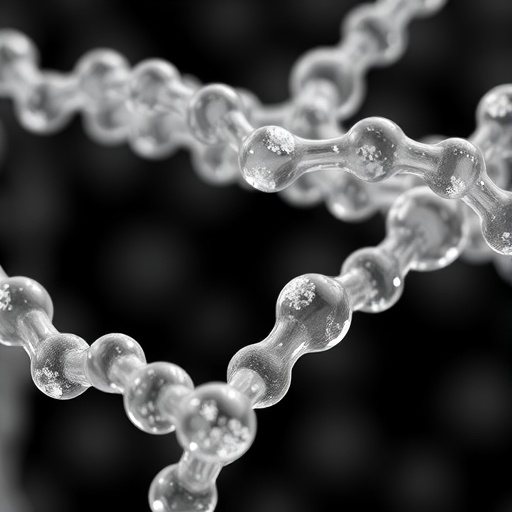In a groundbreaking breakthrough that could revolutionize the future of flexible electronics, a team of South Korean researchers has decoded the intricate molecular mechanisms by which trace amounts of dopants, or impurities, induce polarity switching in organic polymer semiconductors. This discovery opens up unprecedented avenues for manipulating electronic properties within a single polymer material, drastically simplifying device architectures and enhancing stability and efficiency.
Organic polymer semiconductors stand at the forefront of next-generation electronic materials, owing to their lightweight nature, mechanical flexibility, and compatibility with stretchable and wearable technologies. Unlike their rigid, silicon-based counterparts, organic polymers can bend and conform, positioning them as ideal candidates for applications such as flexible displays, electronic skin, and bio-integrated devices. However, their widespread adoption has been hindered by the difficulty in achieving stable n-type conductivity, a critical component of semiconductor function.
Traditional conjugated polymers predominantly exhibit p-type behavior, where positive charge carriers or holes dominate conduction. Attempts to fabricate n-type counterparts—where negative charge carriers or electrons prevail—have often resulted in materials with poor ambient stability, limiting their practical use. This asymmetry in charge carrier dynamics has compelled researchers to seek materials or strategies that can reliably embody both p-type and n-type characteristics, ideally within a singular system.
Enter the phenomenon of doping-induced polarity switching. The research team, led by Professor Kilwon Cho and his collaborators from POSTECH and Sungkyunkwan University, made a seminal leap in demonstrating that modifying the concentration of a single dopant, specifically gold(III) chloride (AuCl₃), can flip the conduction polarity of a polymer from p-type to n-type. This effect means that the same polymer, under different doping conditions, can perform as both electron and hole conductors, a feat that could dramatically streamline the design of organic electronic devices.
Delving into the molecular intricacies, the team meticulously examined polymer films subjected to varying concentrations of AuCl₃. Their spectroscopic and structural analyses revealed dynamic changes in the oxidation states of gold and chloride ions during the doping process. These redox transformations facilitate a substitutional chlorination reaction with the polymer backbone—a chemical interaction that not only alters the polymer’s molecular structure but also reorganizes its electronic landscape.
Specifically, the substitutional chlorination induces a remarkable structural reordering of the polymer chains. This reconfiguration realigns the conjugated polymer backbone, creating new pathways that favor electron transport over hole transport when doping exceeds a critical threshold. This structural modulation of the polymer’s morphology acts as the driving force for the observed polarity switching, bridging a vital gap in the understanding of how molecular chemistry governs macroscopic electronic properties in organic semiconductors.
Building on these insights, the researchers engineered a p–n organic homojunction diode by doping the identical polymer at two distinct concentrations—one region doped to exhibit p-type behavior and the other n-type. This device exhibited extraordinary rectification ratios, surpassing conventional single-material diodes by several orders of magnitude. This performance underscores the potential for simplified, high-performance electronic components fabricated from a singular polymer source, bypassing the necessity for complex multi-material junctions.
The implications of this discovery are profound. By harnessing polarity switching through controlled doping, the research paves the way to develop highly stable, efficient, and mechanically flexible organic electronic devices with simplified manufacturing processes. This strategy could accelerate the advent of ubiquitous wearable technologies, foldable gadgets, and advanced biomedical interfaces by making the electronic core both versatile and robust.
Professor Kilwon Cho and Professor Boseok Kang highlighted the novelty and impact of their findings, stressing that this is the first clear elucidation of the chemical and structural mechanisms enabling polarity switching in conjugated polymers. Their work not only demystifies a fundamental scientific question but also equips materials scientists and engineers with tangible methods to tailor electronic properties at the molecular level, fostering innovation in organic semiconductor design.
This pioneering study was supported by significant national funding from the National Research Foundation of Korea and the Ministry of Science and ICT, underscoring the importance of fundamental research in propelling technological advancements. Their comprehensive approach combining chemical analysis, material synthesis, and device engineering epitomizes the multidisciplinary efforts crucial to breakthroughs in modern materials science.
The ramifications extend beyond fundamental science and into practical application. The ability to fabricate p–n junctions from a single polymer material simplifies device architectures, potentially reducing material costs and complexity in production. Moreover, the enhanced environmental stability of the n-type state achieved here addresses longstanding challenges faced by organic electronics in real-world conditions.
Future research building on these findings will likely explore diverse polymer systems and doping agents, aiming to optimize polarity control, device performance, and environmental resilience. Such investigations will be vital for integrating organic semiconductors into mainstream commercial technologies, heralding a new era of flexible, efficient, and sustainable electronics.
Ultimately, this discovery exemplifies how subtle chemical manipulations at the molecular scale can orchestrate profound changes in material function, highlighting the transformative potential of chemistry-driven design in emerging electronic materials. The convergence of molecular insight and device engineering charts a promising path toward the future of adaptable and resilient electronic technologies.
Subject of Research: Molecular mechanism of doping-induced polarity switching in organic polymer semiconductors.
Article Title: Accompanying Structural Transformations in Polarity Switching of Heavily Doped Conjugated Polymers
News Publication Date: 2-Oct-2025
Web References: https://dx.doi.org/10.1002/adma.202505945
Image Credits: POSTECH
Keywords
Applied sciences and engineering; Electric charge; Charge transfer; Electricity; Physics; Molecular chemistry; Polymer engineering; Polymer chemistry; Electrical conductors; Ferromagnetic semiconductors; Bilayers; Quantum dynamics; Semiconductors; Engineering; Electrical engineering
Tags: advancements in semiconductor materialscharge carrier dynamics in polymersconcentration-controlled dopingflexible and stretchable technologyflexible electronics breakthroughintegrated bio-electronic devicesmanipulation of electronic properties in polymersmolecular mechanisms of dopingn-type conductivity challengesorganic polymer semiconductorsp-type to n-type polymer conversionstability and efficiency in polymers





